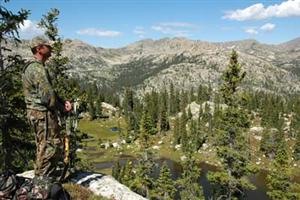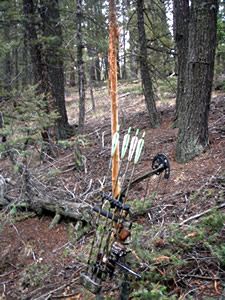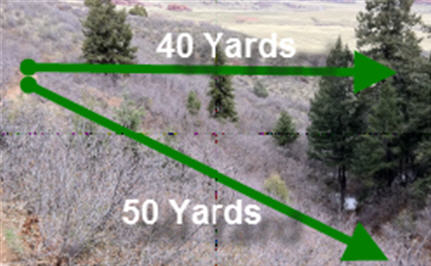Archery Shot Placement
By Dana Gertsch
 You have heard that bull coming for a while now, crashing timber, bugling and snorting. Your buddy is behind you calling and that bull is definitely coming in to the call. The moment of truth is here. You've thought about this day for a long time. For some hunters, this is their first archery hunt for elk, and for others, it’s old hat. You've finally got that shot you've been dreaming of, but what does it take to ensure a good shot, one that puts the animal down quickly? Are you ready?
You have heard that bull coming for a while now, crashing timber, bugling and snorting. Your buddy is behind you calling and that bull is definitely coming in to the call. The moment of truth is here. You've thought about this day for a long time. For some hunters, this is their first archery hunt for elk, and for others, it’s old hat. You've finally got that shot you've been dreaming of, but what does it take to ensure a good shot, one that puts the animal down quickly? Are you ready?
A bow is a primitive weapon, assisting hunters since the dawn of early man. You can't just buy one the week before opening day, fling a few arrows and expect to be ready. The bow is a piece of equipment that takes some thought before purchase. The spectrum of bows is large, with a great deal of variety: long bows, recurve bows, compound bows, 50% let-off, 80% let-off; the list of choices goes on and on. The cost of a good bow rivals or exceeds the cost of a good rifle and scope combination. Do some research and homework as you build your equipment inventory. Serious archery hunters spend hours, days and weeks preparing, practicing and getting their gear ready for the field. We’ll take a few minutes to discuss some of those preparation items.
 Arrow choice is a key consideration. These days most people opt for a carbon arrow due to its strength and durability. But there is more than just picking the right material. It must have the correct spine weight for the draw weight and draw length of your bow. The spine or stiffness of your arrow affects its flight characteristics and thus its accuracy. Your local pro shop has the expertise to help you make the right choice.
Arrow choice is a key consideration. These days most people opt for a carbon arrow due to its strength and durability. But there is more than just picking the right material. It must have the correct spine weight for the draw weight and draw length of your bow. The spine or stiffness of your arrow affects its flight characteristics and thus its accuracy. Your local pro shop has the expertise to help you make the right choice.
Another piece of the arrow equation is the broadhead. There are really two choices here, fixed or mechanical. You could get into a no-win forum flame-throwing contest by questioning someone’s choice one way or the other. Whatever you choose, make sure it shoots properly and is SHARP. Why do I emphasis the sharpness of the broadhead? To ensure a quick and humane harvest of the animal you shoot. A dull broadhead may not cut or slice the vital organs enough to cause massive blood loss. In fact, if your broadhead is dull it may just push the organs, veins, and arteries off to the side with a surprisingly minimal amount of damage. A razor-sharp blade will produce a larger blood trail, allowing you to find your animal. An animal shot with a dull tip may be lost, or worse suffer until it expires. As for me, I cannot sharpen a broadhead. So I've opted for a fixed blade broadhead with replaceable blades. I carry extra blades in my backpack to replace the blades after every missed shot.
How much energy or kinetic energy does it take to put an elk down? Most websites place this value around 40 foot-pounds per square inch. So how do you measure this? First, you will need to measure the speed of your hunting arrow setup (Arrow and broadhead) using a chronograph. Most archery shops have one of these. Shoot at least three arrows, and average out the speed. Next weigh your arrow. Now we do the math. Here is the formula for determining Kinetic Energy:
Energy = .5 * weight * velocity2
As an example, my arrow weighs 477gr and has an average speed of 260 ft/sec. Using this formula, I end up with about 71 ft/lbs of kinetic energy. An easy way to obtain a rough calculation is to use one of the many kinetic energy calculators available on the web. You can even use a Kinetic energy calculator for a bullet, as the end result is KE calculated.
Many people will not start shooting their broadheads until a couple of weeks before the season and immediately discover that their broadheads and field tips do not hit in the same place. In fact they are hitting 6 or more inches from each other. There are two approaches to fixing this. One approach is just moving your sights over to the broadhead point of impact. The other is to broadhead tune your bow. This may require several trips to the range, some fine tuning to your rest, paper tuning, and more. I prefer having my broadheads and field tips hitting the same place. This allows me to stump shoot, and verify my point of impact in the field without damaging your broadheads.
Range estimation is key for bow hunters. No matter how fast your bow will shoot, gravity will affect the arrow, causing it to drop along its flight path. This can be pretty significant if you have a heavy arrow and low draw weight. My bow setup allows the arrow to drop an inch every two yards, or about 5 inches every 10 yards. Elk are big animals, but people miss shots every year. Their size plays tricks on you, especially if you are used to shooting at smaller whitetails. The elk look further away. I practice my range estimation during the year at 3D shoots. I don't shoot for score but will take a shot and then pull out my range finder to verify my estimated range.
I practice shooting out to 60 yards during the summer to help with my shooting form. I can consistently place arrows onto an eight inch paper plate at that distance, but have set my personal maximum range to 45 yards; that is my comfort zone. And that shot will only be taken if everything is perfect, and I’ve ranged the distance. Anything standing still inside 35 yards is a slam dunk. I know this because of the time I’ve spent at the range and other target shoots.
And finally, you have to know your personal maximum effective range. I define mine as that range where I can put a group of five arrows onto an eight inch paper plate consistently. An elk's kill zone is about 25 inches in diameter, but considering excitement and fatigue, this leaves me with plenty of room for error. For some hunters, the range may be 20 yards, while others may feel comfortable at 60 yards or more. Losing an animal because of a risky shot will make you sick to your stomach and ruin a good hunt quickly.
 I know the title of this article is Archery Shot Placement and I am finally getting to that discussion, but without understanding the important point I discussed earlier in the article, you cannot “place the arrow” where you want it to go. Elk are big, tough animals. An elk can survive a poorly placed shot. A good shot is one that will penetrate both lungs and cause a maximum amount of blood loss, rapidly. A broadside or slightly quartering away shot is preferable. Some bad shots definitely include an animal quartering toward you. Here the front leg will obstruct your double lung / heart shot. Don’t take this shot. Another shot to avoid is straight-on. Here you have no chance of a double-lung shot, and have to pray for a heart shot. Yes it may be hard to pass up that one shot opportunity you’ve had all season, but you will feel better later on knowing you did the right thing. So where do you aim to get that double lung shot? Pick a spot about one-third to one-half way up the animal, right behind the front leg. This is the dead center of the vital area. Find this point and fix it in your mind. Aim for this specific spot, don’t aim for the animal. Aim small, miss small.
I know the title of this article is Archery Shot Placement and I am finally getting to that discussion, but without understanding the important point I discussed earlier in the article, you cannot “place the arrow” where you want it to go. Elk are big, tough animals. An elk can survive a poorly placed shot. A good shot is one that will penetrate both lungs and cause a maximum amount of blood loss, rapidly. A broadside or slightly quartering away shot is preferable. Some bad shots definitely include an animal quartering toward you. Here the front leg will obstruct your double lung / heart shot. Don’t take this shot. Another shot to avoid is straight-on. Here you have no chance of a double-lung shot, and have to pray for a heart shot. Yes it may be hard to pass up that one shot opportunity you’ve had all season, but you will feel better later on knowing you did the right thing. So where do you aim to get that double lung shot? Pick a spot about one-third to one-half way up the animal, right behind the front leg. This is the dead center of the vital area. Find this point and fix it in your mind. Aim for this specific spot, don’t aim for the animal. Aim small, miss small.
 How does shooting uphill, downhill or from a tree stand influence your shot? Think about this scenario: You are an accomplished archer and have practiced routinely at 60+ yards with your equipment using the range and the flat field behind your house. You can consistently shoot a tight group at 55 yards and have set your personal maximum effective range at 55 yards. It is opening day; your buddy has called that bull in. You pull your range finder out and see that he is 50 yards, down a steep slope. Since this is in your comfort zone, you draw your bow and take the shot. To your dismay the arrow went OVER the elk. Why? While the distance down the hill was 50 yards, the actual distance was only 40 yards.
How does shooting uphill, downhill or from a tree stand influence your shot? Think about this scenario: You are an accomplished archer and have practiced routinely at 60+ yards with your equipment using the range and the flat field behind your house. You can consistently shoot a tight group at 55 yards and have set your personal maximum effective range at 55 yards. It is opening day; your buddy has called that bull in. You pull your range finder out and see that he is 50 yards, down a steep slope. Since this is in your comfort zone, you draw your bow and take the shot. To your dismay the arrow went OVER the elk. Why? While the distance down the hill was 50 yards, the actual distance was only 40 yards.
When taking shots at an incline, remember it is the horizontal distance that matters. This is distance your arrow is being affected by gravity. Instead of ranging to the animal, you might range to the tree next to the elk, level with your elevation. It's not intuitive, so you should practice these shots before your season. Even when you're familiar with the technique, bring your stump-shooting arrow that you carry for practice, and practice. Find a target down the hill with a tree that comes up to your level, range the horizontal distance, and then take the shot. You may find that a downhill shot will hit a bit high. Then take the same shot uphill. This time it hits a bit low. How much either way isn’t important, as long as you know what adjustments you need to make. I usually don’t worry about the minor differences of shooting uphill verses downhill, but focus on the horizontal distance. You can live with an inch high or low.
Let me close this article with another short scenario, one that can help you picture, in your mind, all of the practice, preparation and decisions I have written about so far. The scenario sums up some of these thoughts, hopefully gets your heart beating just a bit faster and will make you think about that moment of truth. Are you ready?
Your buddy's calling has that bull coming in hard. Where will you take your shot from? You have to think fast. You decide on a spruce tree, with limbs all the way to the ground. Setting up with the tree behind you breaks up your silhouette. Next, pull your range finder out and range the trees, rocks or other features that are within your shooting range. Settle back into your spot and draw your bow to determine if there are branches that get in your way and quietly break them off. Clear away the pine cones and small twigs where you are kneeling on to reduce the risk of making noise when the bull gets close.
 Here he comes, laser eyes on your buddy's location. He is getting close now, but the angle of the shot is bad as he is slightly quartered toward you. You know taking this shot would probably result in a wounded animal, as the leg bone covers his vital area. Wait. Wait for the broadside shot, one that will penetrate both lungs. You can see that when he turns broadside, he'll be covered by a tree, but that also means he won't see you draw. So you wait. You draw your bow as he passes behind the tree. He clears the tree, slightly quartering away. Your shot will hit both lungs now. A quick mew from your buddy and he stops. You lock in on that spot behind his shoulder and the arrow flies. It's a complete pass-through and he starts off down the hill, appearing a bit confused. You throw out a few more cow calls to calm the bull. A few minutes later you hear him hit the ground.
Here he comes, laser eyes on your buddy's location. He is getting close now, but the angle of the shot is bad as he is slightly quartered toward you. You know taking this shot would probably result in a wounded animal, as the leg bone covers his vital area. Wait. Wait for the broadside shot, one that will penetrate both lungs. You can see that when he turns broadside, he'll be covered by a tree, but that also means he won't see you draw. So you wait. You draw your bow as he passes behind the tree. He clears the tree, slightly quartering away. Your shot will hit both lungs now. A quick mew from your buddy and he stops. You lock in on that spot behind his shoulder and the arrow flies. It's a complete pass-through and he starts off down the hill, appearing a bit confused. You throw out a few more cow calls to calm the bull. A few minutes later you hear him hit the ground.
As you wait for the next 30 minutes or so, you reflect on the year. You've made good decisions when it comes to equipment; you’ve practiced, tuned your setup, and patiently waited for the right shot.
Congratulations elk hunter, now the real work starts.

